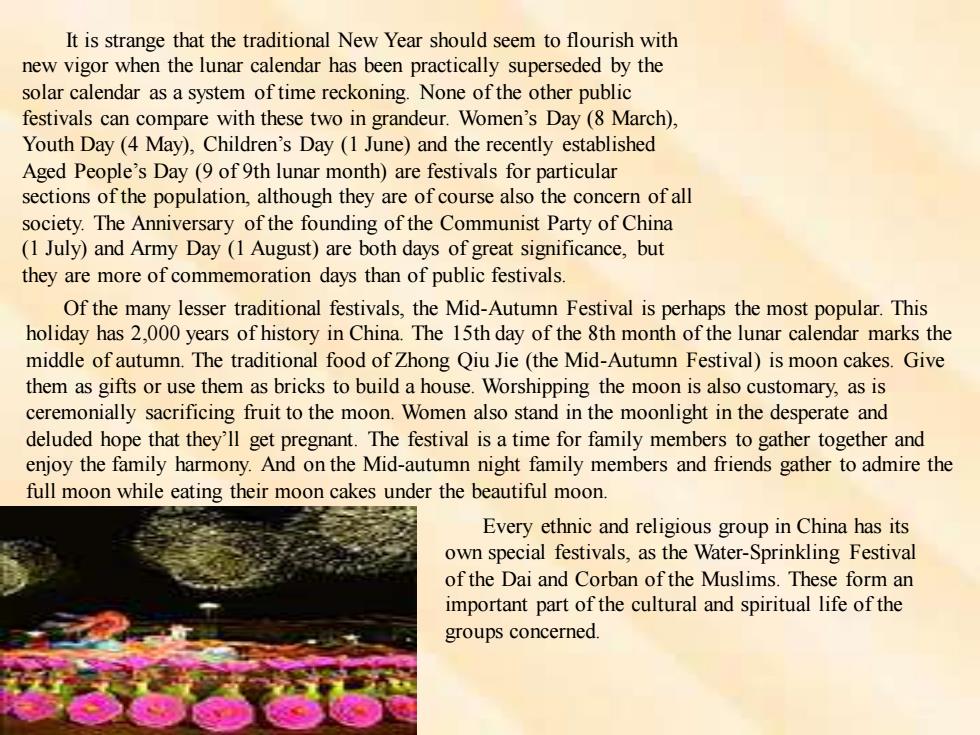正在加载图片...

It is strange that the traditional New Year should seem to flourish with new vigor when the lunar calendar has been practically superseded by the solar calendar as a system of time reckoning.None of the other public festivals can compare with these two in grandeur.Women's Day(8 March), Youth Day(4 May),Children's Day(1 June)and the recently established Aged People's Day (9 of 9th lunar month)are festivals for particular sections of the population,although they are of course also the concern of all society.The Anniversary of the founding of the Communist Party of China (1 July)and Army Day (1 August)are both days of great significance,but they are more of commemoration days than of public festivals. Of the many lesser traditional festivals,the Mid-Autumn Festival is perhaps the most popular.This holiday has 2,000 years of history in China.The 15th day of the 8th month of the lunar calendar marks the middle of autumn.The traditional food of Zhong Qiu Jie(the Mid-Autumn Festival)is moon cakes.Give them as gifts or use them as bricks to build a house.Worshipping the moon is also customary,as is ceremonially sacrificing fruit to the moon.Women also stand in the moonlight in the desperate and deluded hope that they'll get pregnant.The festival is a time for family members to gather together and enjoy the family harmony.And on the Mid-autumn night family members and friends gather to admire the full moon while eating their moon cakes under the beautiful moon. Every ethnic and religious group in China has its own special festivals,as the Water-Sprinkling Festival of the Dai and Corban of the Muslims.These form an important part of the cultural and spiritual life of the groups concerned.It is strange that the traditional New Year should seem to flourish with new vigor when the lunar calendar has been practically superseded by the solar calendar as a system of time reckoning. None of the other public festivals can compare with these two in grandeur. Women’s Day (8 March), Youth Day (4 May), Children’s Day (1 June) and the recently established Aged People’s Day (9 of 9th lunar month) are festivals for particular sections of the population, although they are of course also the concern of all society. The Anniversary of the founding of the Communist Party of China (1 July) and Army Day (1 August) are both days of great significance, but they are more of commemoration days than of public festivals. Of the many lesser traditional festivals, the Mid-Autumn Festival is perhaps the most popular. This holiday has 2,000 years of history in China. The 15th day of the 8th month of the lunar calendar marks the middle of autumn. The traditional food of Zhong Qiu Jie (the Mid-Autumn Festival) is moon cakes. Give them as gifts or use them as bricks to build a house. Worshipping the moon is also customary, as is ceremonially sacrificing fruit to the moon. Women also stand in the moonlight in the desperate and deluded hope that they’ll get pregnant. The festival is a time for family members to gather together and enjoy the family harmony. And on the Mid-autumn night family members and friends gather to admire the full moon while eating their moon cakes under the beautiful moon. Every ethnic and religious group in China has its own special festivals, as the Water-Sprinkling Festival of the Dai and Corban of the Muslims. These form an important part of the cultural and spiritual life of the groups concerned